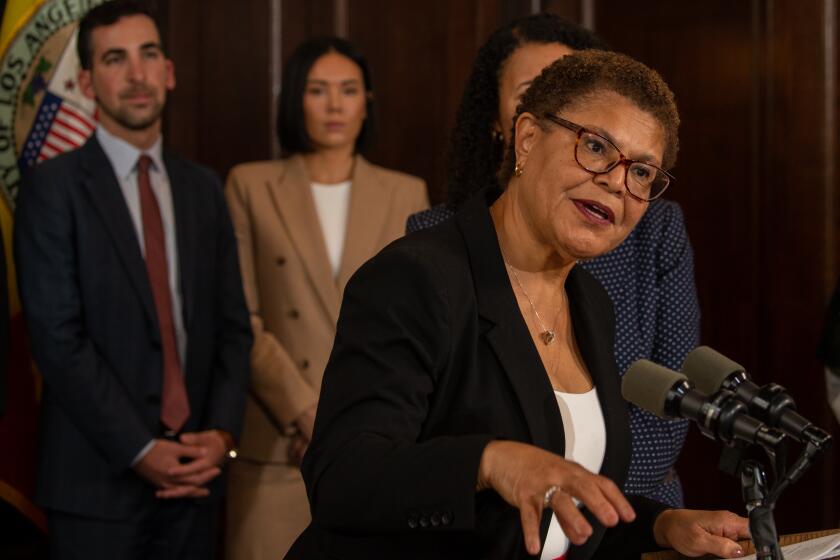Many underinsured for fire
- Share via
Harriet Guttman still tears up when she recounts the devastating loss of her Claremont-area home in last fall’s wildfires. The furniture, photos, her autograph collection -- including one from Mother Teresa -- all were destroyed in the conflagration.
Adding to her heartbreak is the fact that she and her husband, Bob, were grossly underinsured -- by hundreds of thousands of dollars.
“We never expected a fire,” Guttman said. “It was like a tornado.”
Guttman is hardly alone. Hundreds of other fire survivors have learned that their coverage is insufficient to rebuild their homes. Marshall & Swift/Boeckh, a Wisconsin firm that tracks rebuilding costs, estimates that about 64% of U.S. homes, or 43 million, are not sufficiently insured to cover rebuilding costs after a catastrophe.
Last fall’s Southern California wildfires resulted in the total loss of 3,710 homes. The California Department of Insurance has received about 500 complaints stemming from the disaster, about half of which are related to underinsurance problems, said John Garamendi, the insurance commissioner.
“The reasons for underinsuring are simple,” Garamendi said. “People are misled, misinformed or did not have enough coverage for a total loss.”
Above all, Garamendi said, homeowners rarely think that their houses could be destroyed in a disaster. And if it were to happen, they assume that their policies would cover the loss. That is not always the case, however.
Seeking to keep their policy premiums low, many consumers buy only the minimum coverage mandated under the terms of their mortgage contracts, leaving them vulnerable to considerable out-of-pocket expenses if fire does damage or destroy their homes.
Experts say homeowners also have come to rely too heavily on quick phone-survey estimates, which are geared more toward tract houses with no upgrades. These estimates do not include the rebuilding costs for homes with tile, wood floors and better roofing, all of which cost more to replace than standard-issue materials listed in cursory estimates.
The steep rise in construction costs over the last few years has had an effect too. California homeowners who have not increased their coverage since early 2000 face replacement costs that have risen by 21% to 40%, according to Consumer Reports.
Additionally, dramatic home appreciation, which has resulted in a bonanza of home improvements such as new kitchens and room additions, has increased the value of homes. These upgrades require an increase in insurance coverage.
Rebecca Huston learned the hard way about adequately covering replacement costs.
During the Cedar Glen fire near Lake Arrowhead last fall, the 42-year-old writer and producer lost her custom-built redwood home with an art studio and hot tub. She thought her home was properly insured, based on talks with her agent, and was willing to pay top dollar if necessary, but the coverage fell short by more than $200,000.
“The insurance company didn’t pick up all the issues of my house,” Huston said. “I paid for a replacement cost policy, but it didn’t replace it.”
Survivors of the 2003 Southland wildfires complain most bitterly about insurance industry policy misnomers, such as replacement policies with extended coverage. These are popular products that they say mislead consumers into thinking they have purchased total replacement coverage for their homes, when in fact they typically have not. These policies have a dollar limit, plus about a 20% cushion for unforeseen cost overruns.
Karen and Bill Reimus, Scripps Ranch homeowners who lost their home in the Cedar fire last year, purchased a replacement value policy four months before their home was destroyed. The policy was at least $150,000 short of their needs.
“Do the homework,” said Karen Reimus, a lawyer. “Go beyond your agent to find out how much it costs to replace your home and landscaping. Get an independent assessment, and compare with other companies.”
Insurers such as State Farm say that fire survivors’ fears about underinsurance sometimes are prompted by contractors’ initial bids, which often are high. They urge homeowners to get several construction estimates after a fire to avoid unscrupulous contractors.
“The insurance process is ongoing” after a fire, said State Farm spokesman Bill Sirola. “We work with policyholders to make sure they’re made as near to whole as possible.”
One way to ensure that is for homeowners to purchase a guaranteed replacement policy, which provides for a complete home replacement, no matter the cost. But those policies are so prohibitively expensive that they rarely are purchased. Only three companies are known to offer such policies in California.
Five bills before the Legislature, collectively dubbed the Homeowners Bill of Rights -- Southern California Wildfire Survivors Protection Act, are intended to address underinsurance and other homeowner issues. A vote may come as soon as August.
Insurance experts also recommend the following:
* Make sure to have enough coverage in the event of a total loss. Hire a local contractor to compute the price per square foot of replacing your home.
* Reassess your home’s replacement cost each year, and adjust the coverage accordingly. New kitchens, fixtures, room additions, landscaping and higher construction costs require additional coverage.
* Videotape the contents of each room of your house, including the garage, drawers and closets, from socks to wall sockets, and list them in the video and on paper. Make three copies; safeguard them in separate places outside the home.
* Don’t confuse the market value of a home -- the amount a home would get if it were for sale -- with the replacement value, the cost per square foot needed to rebuild the home. Only the latter is covered.
* When buying a home, know that a custom-built luxury home costs more to insure than an inexpensive tract house. Buy coverage accordingly.
* Reduce home-insurance costs by raising the deductible, not by skimping on the coverage.
* If an insurance quote is “quick,” dig deeper. Consider home upgrades, and get more than one estimate.
For information about insurance issues and fire safety preparedness, visit www.insurance .ca.gov or call (800) 927-HELP.
More to Read
Inside the business of entertainment
The Wide Shot brings you news, analysis and insights on everything from streaming wars to production — and what it all means for the future.
You may occasionally receive promotional content from the Los Angeles Times.










